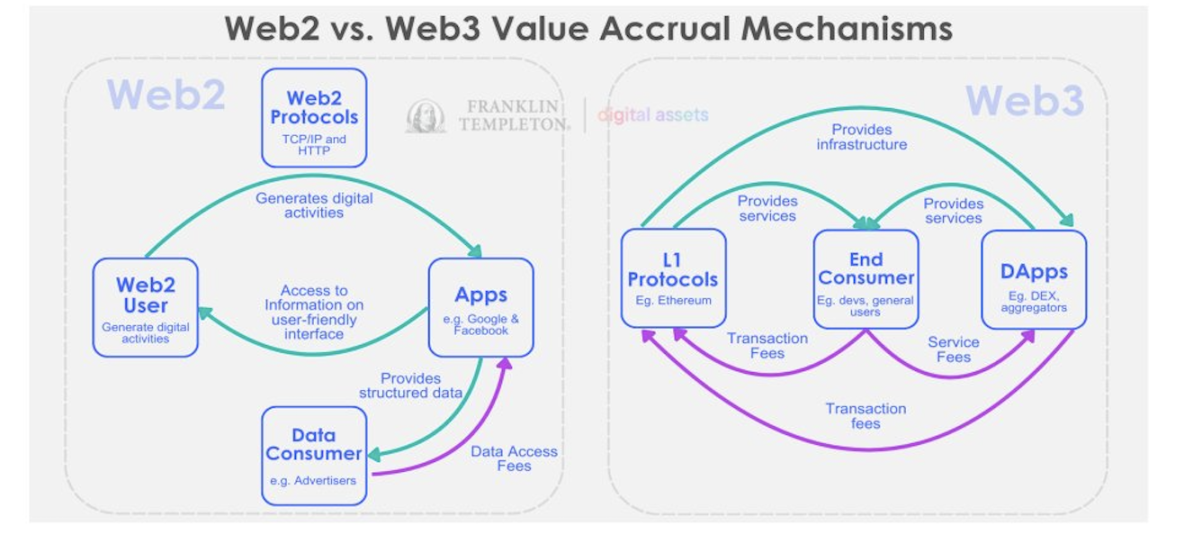Fat Protocol or Fat App? The answer may be Both.
Written by: Franklin Templeton Digital Assets
Translated by: Alex Liu, Foresight News

Since the advent of smart contracts, the accumulation of value in distributed networks has been a highly debated topic. Generally, there are two viewpoints on this topic:
- Believing that value is primarily generated by protocols
- Believing that value is generated by applications built on top of protocols
This study aims to comprehensively evaluate the value accumulation mechanism by examining the history of Web2 and the fundamental differences unique to crypto-based economies.
Web2 Value Capture
To understand the value capture methods in the web, we must first examine Web2—the first digital economy that set the precedent. In Web2, protocols like TCP/IP and HTTP provided the necessary infrastructure for data transmission, greatly increasing global access to information through shared communication standards.
However, due to a lack of effective processing tools, users initially faced limitations in utilizing this data.
Applications like Google, the most widely used search engine in the world, exploited this asymmetry by providing a simple user interface/user experience for ordinary web users to build and facilitate the consumption of digital information. In this way, they created value by enabling users to interact with the emerging data economy. Additionally, by controlling their proprietary ecosystems, these applications could monetize their data assets by packaging and selling analyses and insights on digital behavior.
Notably, these protocols were excluded from monetization because they could not control the flow of consumer data.
As a result, applications were referred to as "fat," while core protocols were considered "thin." This distinction gave rise to the "Fat App" viewpoint, which argues that applications capture greater value by building on and utilizing digital activity rather than merely facilitating basic data transmission. Essentially, the value proposition of Web2 is centered around information dissemination; by providing easy access to content, applications capture all value creation.
Web3 Value Capture
Web3 represents a significant departure from the historical value capture mechanisms of Web2. Unlike Web2, where value generation primarily stemmed from developing consumer-friendly products on top of basic protocols, Web3 derives value directly from the foundational protocols. Layer 1 (L1) protocols facilitate transactions being included in blocks, allowing them to monetize the process by charging transaction fees that users are willing to pay for execution.
Moreover, decentralized applications (dApps) built on these L1 protocols also require fees to utilize this infrastructure. This ability to capture significant value at the protocol level (driven by strong transaction flows from direct consumers and dApps) has led to the emergence of the Fat Protocol viewpoint, which posits that protocols generate more value than applications in Web3.
The Resurgence of the Fat App Viewpoint
While blockchain has introduced potentially groundbreaking changes in the value accumulation mechanisms of protocols, the concept of fat applications has not completely disappeared. In Web3, the open-source nature of L1 blockchains creates a highly competitive yet collaborative environment for dApps, allowing developers to freely access, modify, and build upon these underlying protocols. Similar to Web2, dApps continue to attract users by providing user-friendly services and interfaces. This has resulted in a more nuanced value capture "tug-of-war" compared to Web2.
This trend is particularly pronounced in decentralized finance (DeFi), where dApps capture significant fees by offering specialized and user-friendly financial services. A notable example is the Solana-based dApp Pump.Fun, which achieved a record daily fee of $5.3 million in August 2024, even surpassing the L1 Solana it is built on. By enabling retail users to create tokens, especially meme coins, it capitalized on surging demand to drive revenue growth and demonstrated how customized services can surpass the blockchains they rely on.

As shown in the figure above, the web has introduced a shift in value accumulation, where the protocol layer and application layer capture value in different ways. Like L1 blockchains, protocols generate fees not only from direct user interactions but also from dApp activities built on top of them. On the other hand, the value of dApps comes from direct interactions with end users (often through specialized services).
Although protocols can obtain broader revenue streams, the ability of dApps to charge higher fees for specialized products complicates the determination of which layer captures more value.
Future Outlook and Conclusion
In summary, while the Fat Protocol viewpoint initially suggested that the value of Web3 would primarily reside in the foundational L1 protocols, recent developments reveal a shift towards a more integrated model. Similar to Web2, applications are capturing significant value independent of their underlying protocols, and Web3 is now witnessing decentralized applications (dApps) effectively leveraging retail customer demand and managing complex transactions. Both the Fat Protocol and Fat App arguments have their merits, and there is contention in viewing either as the dominant model. The future of the web is likely to be defined by the collaboration between foundational technologies and innovative applications built on these technologies, indicating that value will emerge from their interactions.
免责声明:本文章仅代表作者个人观点,不代表本平台的立场和观点。本文章仅供信息分享,不构成对任何人的任何投资建议。用户与作者之间的任何争议,与本平台无关。如网页中刊载的文章或图片涉及侵权,请提供相关的权利证明和身份证明发送邮件到support@aicoin.com,本平台相关工作人员将会进行核查。




